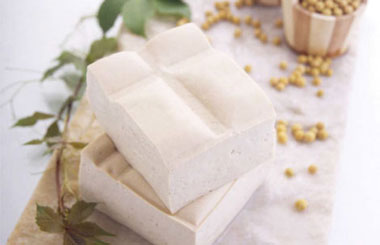Enamored of the curd
Updated: 2016-05-06 06:57
By Pauline D Loh(China Daily Europe)
|
|||||||||

According to legend, it was alchemy that led to the discovery of bean curd. Photos Provided to China Daily
Editor's note: To understand China you have to sit down to eat. Food is the adhesive that holds the Chinese social fabric together. In the face of increasing globalization, food is also one of the last strong visages of community and culture.
Delight that legend says arose from failed alchemy was culinary equivalent of philosophers' stone
Nowhere else in the world has one single humble bean given rise to such a large range of different foods, from juices, pickles, preserves, seasonings, custard to cakes of different textures, and finally, fertilizer.
We are talking about the alchemy of the soybean.
According to legend, it was indeed alchemy that led to the discovery of bean curd, more commonly known as tofu.
Throughout Chinese history, those who ruled often were afraid of death, losing all they had gathered, or of having to leave all that power and glory. From Emperor Qinshihuang of the Qin Dynasty (221-206 BC) onward, they have tried to uncover the recipe for immortality.
So it was with Liu An, whose little fiefdom was in Huai'an, in present day Anhui province. In that beautiful land full of springs, streams and picturesque mountains, Liu An gathered the best Taoist masters - eight of them - and started his search.
In their attempts, they drew water from the region's natural springs and cooked ground up soybeans to create a base for that elusive pill. They didn't succeed, but what was left in the tripod was a pure, white jelly-like substance.
A brave man tasted it, and the rest is history.
That was more than 2,000 years ago, and in the interim, bean curd has become one of the most important ingredients China has contributed to the world.
As the Chinese ventured out, they brought the culture of bean curd with them, so much so that it took on a life of its own, adapting to the cuisines of various countries from Japan and Korea in the north to the Malay and Indonesian archipelagos to the south.
Various forms of bean curd and its derivatives, too, have become the backbone of vegetarian cuisine in the global meatless movement.
Soybean products are a good source of vegetable protein, and after being processed, most no longer have that embarrassing side effect that made the bean itself so unpopular - flatulence.
Tofu is but only one product, and the textures range from very soft to very hard.

One of the best breakfasts you can have in China is a piping hot bowl of soft bean curd, called doufunao in the north and doufuhua in the south. Doufunao literally means tofu brains while doufuhua is definitely more lyrical, translating as tofu flowers.
The northerners prefer a savory version, dousing their soft bean curd with a brown sauce often laced with strips of mushrooms and a few dried daylily buds. In the south, the tender jelly is sweetened with syrups made from plain or brown sugar and flavored with ginger juice.
Hardened to varying degrees, tofu is also used in cooking dishes.
No one cooks tofu better than the chefs who specialize in Huainan cuisine, right from the region where it was first invented.
Here, tender blocks of tofu challenge the knife skills of chefs who float strands as thin as hair in rich chicken stock. Or they deep-fry bean curd so that its texture changes and then braise the entire block in a gravy made with soy sauce and sweet spices. The deep-fried tofu acts like a sponge, absorbing all the flavors and aromas.
Soft blocks of tofu are also steamed to retain their original bean flavor, and may be drizzled with soy sauce or oyster sauce and garnished with a sprinkle of chopped spring onions.
That is its simplest form, but tofu can become very elaborate.
Cubes of a harder version may be deep-fried into puffs and then stuffed with a fish paste to create a dish popular with the Hakka community - niangdoufu.
Or the curds may be aged and fermented to create that notorious snack that has the uninitiated holding their noses. Stinky tofu is something you either love or hate.
In the Jiangsu-Zhejiang region, stinky tofu is legendary, having made it into literary classics such as native son Lu Xun's works.
Across the Straits, Taiwan's famous night markets must have at least one or two stinky tofu stalls. It's deep-fried, served with pickled cabbage and sweet chili sauce, boldly advertising its presence through its lovely pungency.
Back in my Yunnan, slightly fermented tofu is sold at breakfast stalls, sprinkled with chopped peanuts, chili sauce and cilantro. That combination of aromas still has me drooling at the thought. You can always brush your teeth later, or chew on fresh mint, like the locals do.
Tofu is an amazing ingredient, and this is merely just the tip. Next week, we look at the sauces and seasonings that are made from the mighty soybean.
paulined@chinadaily.com.cn
Two dishes to try
Peace for young and old
Tender tofu and soft fish paste in custard translate to a dish suitable for both grandparents and grandchildren.
1 block silken tofu
1 cup fish, finely minced
1 teaspoon cornstarch
Plenty of salt and pepper
3 eggs, beaten
3 tablespoons chicken stock or water
Sesame oil, soy sauce
Mash tofu into smaller pieces, but do not reduce to mush.
Add salt and pepper to minced fish and cornstarch. Use teaspoon to divide paste into bite-sized clumps. Place broken up tofu and minced fish in deep platter, spread evenly.
Mix beaten eggs with stock (or water), pour gently over tofu and minced fish.
Steam over gentle heat for 20-25 minutes. The low heat and longer cooking time ensure your custard won't puff up like a beehive.
Remove from steamer and drizzle with sesame oil and soy sauce. Serve.
Note: Any fish such as salmon or cod works well. Remove skin and bones and mince, either by hand or in a food processor.
Steamed tofu with spicy mince

This is a dish that contrasts the simple texture of the silken tofu with the stronger flavors of the spicy mince. You can moderate the heat by adding more or less chili.
1 block silken tofu
100 g minced pork, beef or lamb
1 tablespoon black bean sauce
2-3 cloves garlic, minced
1-2 red chili peppers, seeded and minced
Salt and pinch of sugar
Cilantro leaves, for garnish
Mix black bean sauce, garlic, chili, and taste before adding salt and sugar. Mix in the minced meat.
Cut off corners of the bottom of silken tofu container so it comes out easier. Place block of tofu on a plate that can go into steamer.
Spread mince and sauce mix evenly over block of tofu and steam for 15 minutes on high heat. The water must be boiling before you place tofu in steamer. Remove, garnish with cilantro leaves and serve.
Today's Top News
Testing times
Big hopes as China hosts the G20
Inspectors to cover all of military
Britons embrace 'Super Thursday' elections
Campaign spreads Chinese cooking in the UK
Trump to aim all guns at Hillary Clinton
Labour set to take London after bitter campaign
Labour candidate favourite for London mayor
Hot Topics
Lunar probe , China growth forecasts, Emission rules get tougher, China seen through 'colored lens', International board,
Editor's Picks

|

|

|

|

|

|







